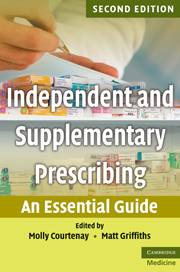Book contents
- Frontmatter
- Contents
- List of contributors
- Foreword to the second edition
- Preface to the second edition
- 1 Non-medical prescribing: an overview
- 2 Non-medical prescribing in a multidisciplinary team context
- 3 Consultation skills and decision making
- 4 Legal aspects of independent and supplementary prescribing
- 5 Ethical issues in independent and supplementary prescribing
- 6 Psychology and sociology of prescribing
- 7 Applied pharmacology
- 8 Monitoring skills
- 9 Promoting concordance in prescribing interactions
- 10 Evidence-based prescribing
- 11 Extended/supplementary prescribing: a public health perspective
- 12 Calculation skills
- 13 Prescribing in practice: how it works
- 14 Minimising the risk of prescribing error
- Index
- References
2 - Non-medical prescribing in a multidisciplinary team context
Published online by Cambridge University Press: 10 January 2011
- Frontmatter
- Contents
- List of contributors
- Foreword to the second edition
- Preface to the second edition
- 1 Non-medical prescribing: an overview
- 2 Non-medical prescribing in a multidisciplinary team context
- 3 Consultation skills and decision making
- 4 Legal aspects of independent and supplementary prescribing
- 5 Ethical issues in independent and supplementary prescribing
- 6 Psychology and sociology of prescribing
- 7 Applied pharmacology
- 8 Monitoring skills
- 9 Promoting concordance in prescribing interactions
- 10 Evidence-based prescribing
- 11 Extended/supplementary prescribing: a public health perspective
- 12 Calculation skills
- 13 Prescribing in practice: how it works
- 14 Minimising the risk of prescribing error
- Index
- References
Summary
The demands by patients for a more streamlined, accessible and flexible service (Department of Health (DoH) 2000), demands for the integration of services (DoH 2008) and a high-quality accountable service, and demands for roles which extend beyond traditional boundaries acknowledging the range of knowledge and skills held by practitioners and offering them the opportunity to achieve their full potential (DoH 2001; 2002), have meant that the roles of healthcare professionals have changed dramatically over recent years. These changes have placed a great emphasis on teamwork and multiprofessional co-operation.
The success of non-medical prescribing is dependent upon the contributions from a number of practitioners, including specialist nurses, pharmacists and doctors, and the ability of these professionals to work together as a team. This chapter examines the key issues that need to be considered by healthcare professionals if non-medical prescribing is to be implemented effectively. It commences with an exploration of teamwork and then moves on to discuss clinical governance. Communication, sharing information and supplementary prescribing are then examined.
Teamwork
In order to work effectively as a team, a number of key elements are required. These include:
Effective verbal and written communication.
Enabling and encouraging supervision.
Collaboration and common goals.
Valuing the contributions of team members and matching team roles to ability.
A culture that encourages team members to seek help.
Team structure (Vincent et al. 1998).
Underpinning each of the above elements is the need for team members to have a clear understanding of one another's roles and the ability to communicate with one another.
- Type
- Chapter
- Information
- Independent and Supplementary PrescribingAn Essential Guide, pp. 7 - 14Publisher: Cambridge University PressPrint publication year: 2010

